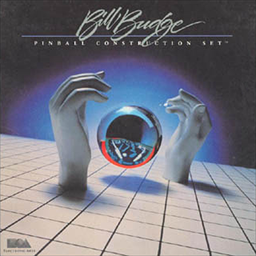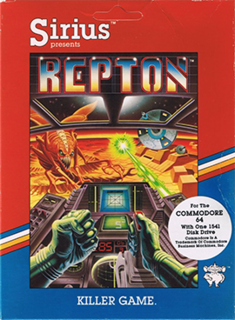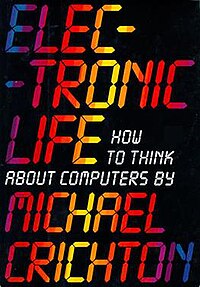
Jerry Eugene Pournelle was an American polymath: scientist in the area of operations research and human factors research, science fiction writer, essayist, journalist, and one of the first bloggers. In the 1960s and early 1970s, he worked in the aerospace industry, but eventually focused on his writing career. In an obituary in Gizmodo, he is described as "a tireless ambassador for the future."

John Michael Crichton was an American author and filmmaker. His books have sold over 200 million copies worldwide, and over a dozen have been adapted into films. His literary works are usually within the science fiction, techno-thriller, and medical fiction genres, and heavily feature technology. His novels often explore technology and failures of human interaction with it, especially resulting in catastrophes with biotechnology. Many of his novels have medical or scientific underpinnings, reflecting his medical training and scientific background.
The video game crash of 1983 was a large-scale recession in the video game industry that occurred from 1983 to 1985, primarily in the United States. The crash was attributed to several factors, including market saturation in the number of game consoles and available games, as well as waning interest in console games in favor of personal computers. Revenues peaked at around $3.2 billion in 1983, then fell to around $100 million by 1985. The crash abruptly ended what is retrospectively considered the second generation of console video gaming in North America.

Star Raiders is a first-person space combat simulator for the Atari 8-bit family of computers. It was written by Doug Neubauer, an Atari employee, and released as a cartridge by Atari in 1979. The game is considered the platform's killer app. It was later ported to the Atari 2600, Atari 5200, and Atari ST.

Pinball Construction Set is a video game by Bill Budge written for the Apple II. It was originally published in 1982 through Budge's own company, BudgeCo, then was released by Electronic Arts in 1983 along with ports to the Atari 8-bit family and Commodore 64.

M.U.L.E. is a seminal multiplayer video game written for the Atari 8-bit family of home computers by Ozark Softscape. Designer Danielle Bunten Berry took advantage of the four joystick ports of the Atari 400 and 800 to allow four-player simultaneous play. M.U.L.E. was one of the first five games published in 1983 by new company Electronic Arts, alongside Axis Assassin, Archon: The Light and the Dark, Worms?, and Hard Hat Mack. Primarily a turn-based strategy game, it incorporates real-time elements where players complete directly as well as aspects that simulate economics.

Choplifter is military themed scrolling shooter developed by Dan Gorlin for the Apple II and published by Broderbund in 1982. It was ported to Atari 5200, Atari 8-bit family, ColecoVision, Commodore 64, VIC-20, MSX, and Thomson computers. Graphically enhanced versions for the Atari 8-bit family and Atari 7800 were published in 1988 by Atari Corporation.

Star Trek is a text-based strategy video game based on the Star Trek television series and originally released in 1971. In the game, the player commands the USS Enterprise on a mission to hunt down and destroy an invading fleet of Klingon warships. The player travels through the 64 quadrants of the galaxy to attack enemy ships with phasers and photon torpedoes in turn-based battles and refuel at starbases in order to eliminate all enemies before running out of time.

Starcross is a 1982 interactive fiction game written by Dave Lebling and published by Infocom. It was released for the IBM PC, Apple II, Atari 8-bit family, Commodore 64, TRS-80, TI-99/4A, and later the Atari ST and Amiga. The game was Infocom's fifth game and first in the science fiction genre. It takes place in the year 2186, when the player's character is a lone black hole miner exploring an asteroid belt. It sold 90,315 copies.

Temple of Apshai is a dungeon crawl role-playing video game developed and published by Automated Simulations in 1979. Originating on the TRS-80 and Commodore PET, it was followed by several updated versions for other computers between 1980 and 1986.

Zork: The Great Underground Empire - Part I, later known as Zork I, is an interactive fiction video game written by Marc Blank, Dave Lebling, Bruce Daniels, and Tim Anderson and published by Infocom in 1980. It was the first game in the Zork trilogy and was released for a wide range of computer systems, followed by Zork II and Zork III. It was Infocom's first game, and sold 378,000 copies by 1986.

The Epson QX-10 is a microcomputer running CP/M or TPM-III which was introduced in 1983. It was based on a Zilog Z80 microprocessor, running at 4 MHz, provided up to 256 KB of RAM organized in four switchable banks, and included a separate graphics processor chip (µPD7220) manufactured by NEC to provide advanced graphics capabilities. In the USA and Canada, two versions were launched; a basic CP/M configuration with 64 KB RAM and the HASCI configuration with 256 KB RAM and the special HASCI keyboard to be used with the bundled application suite, called Valdocs. The European and Japanese versions were like the CP/M configurations. TPM-III was used for Valdocs and some copy protected programs like Logo Professor.

Repton is a Defender-inspired game written by Dan Thompson and Andy Kaluzniacki for the Apple II and published by Sirius Software in 1983. It was ported to the Atari 8-bit family, and Commodore 64.

Time Bandit is an action-adventure game written for the TRS-80 Model I by Bill Dunlevy and Harry Lafnear and published by MichTron in 1983. It was ported to the TRS-80 Color Computer and Dragon 32, but enjoyed its greatest popularity several years later as an early release for the Atari ST. It was also released for the pseudo-PC-compatible Sanyo MBC-55x with 8-color display. Amiga and MS-DOS versions were ported by Timothy Purves.
Electric Pencil, released in December 1976 by Michael Shrayer, was the first word processor for home computers.

GATO is a real-time submarine simulator first published in 1984 by Spectrum HoloByte for MS-DOS. It simulates combat operations aboard the Gato-class submarine USS Growler (SS-215) in the Pacific Theater of World War II. GATO was later ported to the Apple IIe, Atari ST, and Macintosh. In 1987 Atari Corporation published a version on cartridge for the Atari 8-bit family, to coincide with the launch of the Atari XEGS.

This article is an overview of programs available for the Atari 8-bit family of home computers. Software was sold both by Atari, Inc. and third parties. Atari also distributed software through the Atari Program Exchange from 1981 to 1984. After APX folded, many titles were picked up by Antic Software.

Legionnaire is a computer wargame for the Atari 8-bit series created by Chris Crawford in 1982, and released through Avalon Hill. Recreating Julius Caesar's campaigns in a semi-historical setting, the player takes command of the Roman legions in real-time battles against the barbarians.
The Z-100 computer is a personal computer made by Zenith Data Systems (ZDS). It was a competitor to the IBM PC.

Byte was an American microcomputer magazine, influential in the late 1970s and throughout the 1980s because of its wide-ranging editorial coverage. Whereas many magazines were dedicated to specific systems or the home or business users' perspective, Byte covered developments in the entire field of "small computers and software", and sometimes other computing fields such as supercomputers and high-reliability computing. Coverage was in-depth with much technical detail, rather than user-oriented.

















